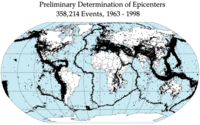
Photo from wikipedia
Abstract DInSAR data provide a powerful tool to recognize the Earth's surface where permanent deformations are concentrated and undergo the strongest ground motion during an earthquake, i.e., defining the epicentral… Click to show full abstract
Abstract DInSAR data provide a powerful tool to recognize the Earth's surface where permanent deformations are concentrated and undergo the strongest ground motion during an earthquake, i.e., defining the epicentral area. We analyzed three recent seismic events in the Apennines belt in Italy related to extensional and contractional earthquakes and documented that the largest macroseismic intensity is recorded where the ground underwent the largest vertical component of motion and the stronger vertical component of the peak ground acceleration. Besides site amplification effects that may occur everywhere even outside the epicentral area, we infer that the vertical oscillations in the so-called near-field allow the horizontal shaking to be more effective, hence producing larger damage above the active crustal volume. The active volume is the one moving vertically and is contemporaneously crossed by seismic waves nucleated by the shear on the fault. The surrounding passive volume in the far field is only crossed by seismic waves. The near field areas are elliptical and cover areas of 300–600 km2 for a range of Mw 6–6.9, and they should be the areas where the highest seismic hazard must be expected. Therefore, their area is too large to be neglected for seismic hazard assessment.
Journal Title: Engineering Geology
Year Published: 2021
Link to full text (if available)
Share on Social Media: Sign Up to like & get
recommendations!